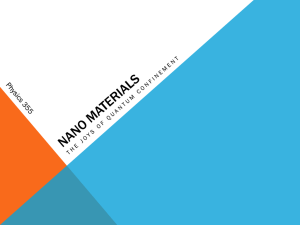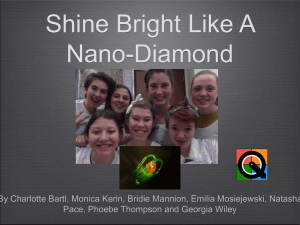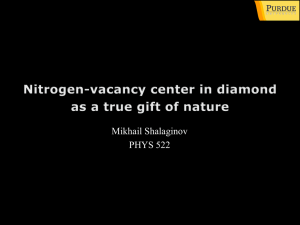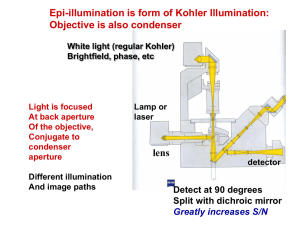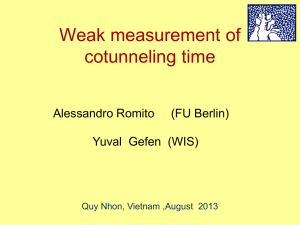Ben Gurion University Atom Chip Group
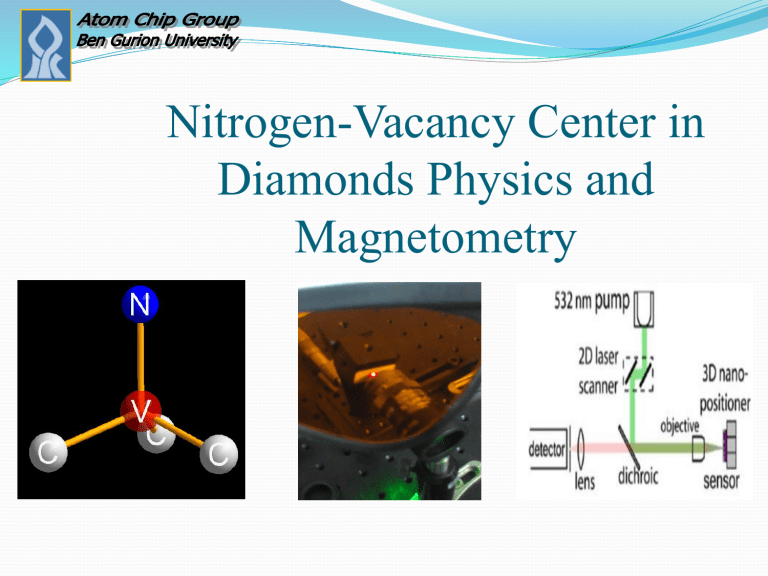
Nitrogen-Vacancy Center in
Diamonds Physics and
Magnetometry
Outline
Quantum systems, their hallmarks and technological applications.
Why can’t Quantum mechanics be observed in solid states.
The nitrogen-vacancy center in diamonds, a unique room-temperature quantum system
Using the nitrogen-vacancy as a magnetic sensor for scientific and technological applications
2
Quantum systems
Superposition
Uncertainty Principle
< Δ𝑋 >< Δ𝑝 > ≥ ℏ
2
High precision measurement Quantum computing
3
Quantum systems
Degrees of freedom splits the energy levels 𝑚 𝑠
=
1
2 𝑚 𝑠
= −
1
2 𝑚
𝐼 𝑚
𝐼 𝑚
𝐼 𝑚
𝐼
1
=
2
= −
1
=
2
= −
1
2
1
2
In solid state we almost always get
Electronic band structure
Very short coherence time due to interactions with phonons
4
The Nitrogen-Vacancy center in diamond
• Diamond is an FCC carbon crystal
• There is natural abundance of nitrogen in the crystal
• Vacancy is generated using high energy radiation.
• The crystal is annealed to trap the vacancies near the N atoms
• The resulting center has C3v symmetry and a spin-1 behavior
5
The Nitrogen-Vacancy center in diamond
Green light generates optical pumping to ms=0.
MW repopulates 𝑚 𝑠
= ±1 leading to a reduction in fluorescence.
Magnetic field splits the spectrum
Only the projection across the NV center is measured = orientation dependent
6
The Nitrogen-Vacancy center in diamond
𝐵 ≈ 0.5 𝐺
𝐵 ≈ 15 𝐺
0.99
0.95
0.9
2.8
2.9
0.35
0
MW [GHz]
0.37
R
= 2.15 MHz
T
2
*
=0.56
s
0.36
1
Time [
s]
2
0.98
0.97
2.8
ms=-1
2.9
MW [GHz
] ms=1
The angle with the magnetic field
109.5°
7
Summery
Quantum systems, their hallmarks and technological applications.
Why can’t Quantum mechanics be observed in solid states.
The nitrogen-vacancy center in diamonds, a unique room-temperature quantum system
Using the nitrogen-vacancy as a magnetic sensor for scientific and technological applications
8
Thank You
http://www.bgu.ac.il/atomchip/
𝑚 𝑠
=
1
2 𝑚 𝑠
= −
1
2 𝑚 𝑚
𝐼 𝑚 𝑚
𝐼
𝐼
𝐼
=
1
2
= −
1
1
2
=
2
1
= −
2
10
11
12

